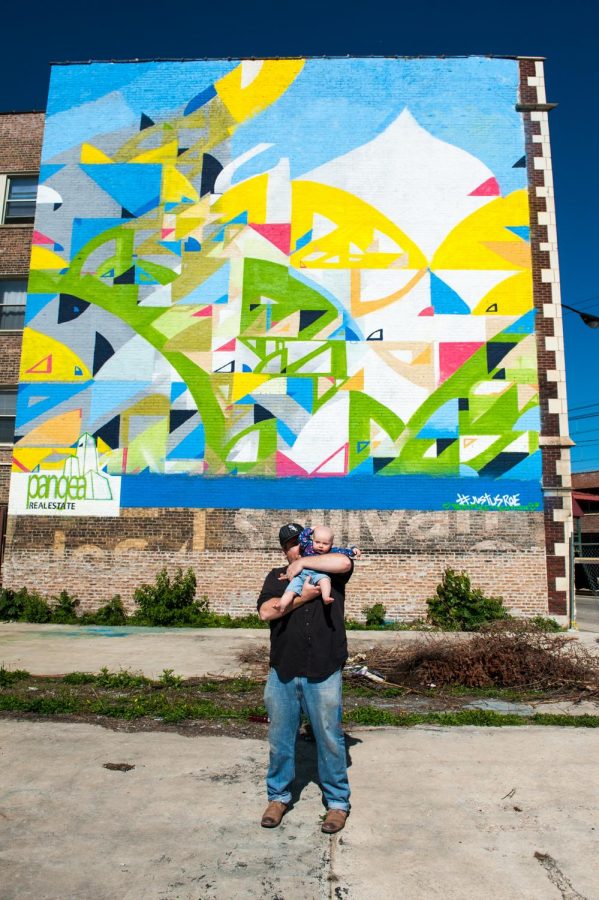Alumni bring style back for Big Walls
Justus Roe, a 2008 interactive arts & media alumnus; Don’t Fret, a photography alumnus; and Ruben Aguirre, a 2002 art + design alumnus, all said they are excited to return to Columbia to create murals on a large scale for Big Walls.
May 7, 2016
Three alumni have been invited to bring their unique styles to campus with their abstract, graffiti-like and cartoon-inspired styles as a part of Columbia’s Big Walls mural initiative.
Justus Roe, a 2008 interactive arts & media alumnus, has been invited by Vice President of Student Success Mark Kelly, Director of Internal and External Partnerships Norman Alexandroff and Facilities and Operations Architect Jacob Chartoff to create a mural for the 1001 S. State St. Building and the Golub Real Estate Investment and Development Company, located at 625 N. Michigan Ave.
Roe said in an April 27 interview that he always wanted to create large-scale work alongside global artists.
Roe said he does large-scale improvised abstract paintings in a style that blends traditional abstract painting and “wildstyle graffiti writing” across different walls.
“I look at each wall, location, neighborhood and interior as a unique frame to work within,” Roe said. “Since most of the work I do is improvised or freestyled in situ, the environment around each wall definitely plays a big part in decisions I am making while painting.”
Don’t Fret, a Chicago-based artist and photography alumnus, said Kelly invited him to participate in the project. Don’t Fret added that he helped connect Kelly and Patrick Hull, owner and curator of Vertical Gallery. Don’t Fret also created work for a display in the Hokin Gallery in the Wabash Campus Building, 623 S. Wabash Ave.
Don’t Fret said his painting will be displayed on the north-facing wall of the Roosevelt Hotel, 1152 S. Wabash Ave., and humorously reflect on his experiences in Chicago and at Columbia. He said his work typically consists of figurative illustrations and cartoons, as well as phrases written inside and around his work.
“My work at times is skeptical, and I feel like I’m always questioning the world around me and the way the world works,” Don’t Fret said. “I am always reflecting on things, and there can be dry humor involved at that.”
Don’t Fret said he has always seen himself as a “glass half-empty” personality and has used humor in his work to discuss and engage with people on his views and deal with dark times through his illustrations. He said some negative topics he addresses include hatred, gluttony, greed and corruption.
Don’t Fret said he approaches street art differently than he would pieces in a gallery show.
“I’m interested in different contexts, life in cities and life in general, and trying to find little absurdities and little things that make me mad or make me laugh,” he said. “There is a lot of humor in the modern age and our relationship to food, technology, religion and our own history.”
Ruben Aguirre, a 2002 art + design alumnus, said his style has developed over time and is currently a culmination of graffiti, design, mural techniques and public space intervention. Aguirre said he focuses more on the location he paints.
“Now, I am focusing on [locations] where I can paint that I can actually contribute to the space,” Aguirre said. “What can I give to this space? It’s more of a giving process than a taking process.”
Aguirre said he enjoys painting on architectural structures and thinks the mural, to be located on the south-facing side of the Goodman Center, 501 S. Wabash Ave., will be a physical challenge to take on because of its large scale.
Aguirre said graffiti has a duality that consists of the design and the location of where the art develops. He said a constant change in location contributes to the graffiti and artistic process.
“It’s nice to paint a different location every time,” Aguirre said. “It’s fresh, it’s new and it’s very stimulating. There are new challenges with every location, and there’s a different vibe to all of it.”
Aguirre said audience accessibility to his art is what motivates him to create graffiti.
“I like making art that anyone can see at any time,” Aguirre said. “I like trying to manipulate a space that people walk by every day. Just to change a visual landscape for people is fun to me.”








